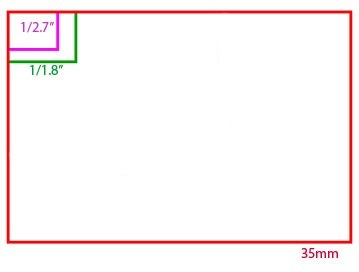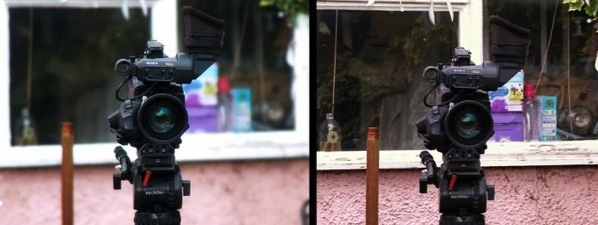
First off, you really need to understand why you need it…and I will try and explain in English rather than overload you with technobabble (although there will, inevitably, be a bit!)
Let’s start with “Depth of field”, this basically refers to how much of the image you film/ photograph is in focus and how much is out of focus. A deep depth of field means almost everything is in focus in the frame, from far away to close up. A shallow depth of field is the opposite where a selective part of the frame is chosen to be in focus This is used to draw your attention to something in particular. It also makes the image more three dimensional, less flat. It’s a very useful tool in film-making and photography. Generally this is achievable with full size cameras by shooting wide open, getting far away from object as you can and zooming in to the bit you want in focus.
With the advent of smaller cameras came smaller image sensors. This causes problems with narrow depth of field. Basically the smaller the sensor the harder it is to get that shallow depth of field. Full size cameras normally have 2/3 inch sensors, cameras like the F350 and EX1/ EX3 have 1/2 inch sensors then cameras like the HVX200, Z1, Z7, Canon A1 etc have 1/3 inch sensors. Sony’s V1 camera has a 1/4 inch sensor, tiny!
So what is the solution? There is only so far back you can go and so much you can zoom in so that is where 35mm adaptors come in.
35mm film and digital cameras are capable of incredible shallow depth of field, way more than even 2/3” cameras as their equivalent sensors are so much bigger, so clever boffins created ways to give the same shallow DOF characteristics of these cameras. They did this by creating the Depth Of Field adaptor, otherwise known as the 35mm adaptor. Here is wikipedia explaining it in a more coherent way than me!
A DOF adapter looks to take the place of the camera’s sensor and use a focusing plate to display an image through the external lens attached to the adapter. Since this image is focused onto a translucent screen (similar to how one would look at a focused image through a system camera’s viewfinder), the camcorder is able to frame this intermediate screen and record it. The principle of one of these adapters is similar to pointing a video camera at a movie screen. The lens attached to the adapter now takes the job of the camcorder’s focusing and aperture mechanisms, as the camcorder’s only responsibility at this point is to record what is being projected onto the focusing screen (called backfocus).
Simple idea, but hard to get right. There are number of good adaptors out there, the M2, Brevis 35, SGPro and the Letus.
These use various focusing plates (or ground glass, called that as it is literally finely ground piece of glass). The all vibrate and spin, the reason they do this is to get rid of the pattern created by making it translucent. A vibrating one shakes the rectangular glass on 4 axis, the spinning one spins a circular one to do it.
The advantage of spinning versus vibrating is simple. If you get dust of the vibrating one you will see it, even if it vibrates, but the spinner hides dust. Also, generally spinners let you stop down more letting you get a deep depth of field and use higher shutter speeds before you start to see the glass pattern.
There are a number of downsides to these adaptors. They lose light, some more than others and require more glass on top of the lens you are already using. Some cameras with removable lenses can use adaptors with relay lenses instead of normal video lenses. These are fixed focal length lenses designed to be the perfect length to focus in on the ground glass. Making the camera shorter and improving low light sensitivity. As long as the glass is fast enough!
Good lenses cost money. Prime lenses (fixed focal length) are normally faster than zooms, but are inconvenient due to the inability to zoom (although you can zoom into the ground glass more with some adaptors to change the frame size). Zooms are convenient and are generally way slower. There are constant f2.8 aperture zooms available but they are expensive. Also compare this to the speeds of most of my primes, which are f1.4. Cheap zooms often start at f3.5 and go to f5.6 on the long end. These are not good enough for 35mm adaptors. For more information on lenses please visit my lenses page on my forum…
Which one is best? Well they all do the same job with varying degrees of success. I own them all except the SGPro and the one I use all the time is the quite wonderful Letus Ultimate which is my work shows really deserves it’s name, although people are getting amazing success with the others…
One thing you need to be aware of is a DOF adaptor will flip the image upside down, this is because a lens always projects an image this way round. It’s physics! Now the camera lens is flipped right way round by the camera, but by putting another piece of glass in front of it means your image will be upside down both in camera and recording. The solution is either have a camera that can invert the image, basically the JVC HD200 and 250 or get a flip attachment for your adaptor. The Letus only comes in one form and that is with a built in flip. All the others are modular and I cannot recommend enough you getting one for your adaptor.
When it comes to critical focus this is when things get difficult. With a shallow DOF focus is hyper critical and every cameras bar one has a sub par LCD for focusing. Only the EX1 and EX3 have usable LCD, the other cameras really all need external monitors.
With cameras like the EX3, Canon XL and JVC HD which have removable lenses, sticking a 35mm lens onto body will not affect the DOF at all as the sensor hasn’t changed size, all you are doing is projecting a very large image onto a very small sensor which means most of the image is lost and lens’ true length is multiplied 7 or 8 times. so a 100mm lens becomes a 700mm lens. Great for wildlife, crap for anything else. You need that 35mm sensor or a fake 35mm sensor like you get in these adaptors.

Follow focuses are essential if you plan to do rack focus mid shot, touching the lens barrel will cause wobble. Redrock and Zacuto both maker terrific follow focuses and I thoroughly recommend them both.
Don’t forget to watch the Letus Extreme demo video to really see the difference in action!
Also don’t forget the have the ability to get a shallow depth of field doesn’t mean EVERYTHING should be crazy shallow. Use that to enhance your storytelling, also don’t shy away from big wide, sure most will be in focus but it’s all about getting that lovely filmic, organic look and that is not to do with shallow DOF.
There is one main thing I forgot to mention about 35mm adaptors. Getting one will not make you shoot beautiful pictures. You can shoot beautiful pictures without one very easily. It’s how you use your camera that is more important. If you are not getting great results without one don’t think this is the answer to all your problems. It most likely isn’t. They are expensive when you buy fast glass, they are hard to use and get consistently good results from, but when you do they are mind blowing, but it takes a lot of time and practice. See how good you can get without one first, then when your normal pics are wonderful, jump in. You won’t regret it!
There never has been a more exciting time in Indie film making than right now. The 35mm market is as Will Ferrell’s Mugatu might say “SO hot right now”. Letus have the Ultimate out, an amazing attack on the pro market dominated by P&S and Movietube, capable of incredible images. Cinevate have all sorts of innovations with their Brevis and SGPro have announced the astonishingly good looking Blade. Redrock meanwhile are concentrating on superb accessories but who know what is around the corner!? All I know is the more these guys work harder the better it is for us.
Now if you have any other topics you think I should cover in the FAQ section please let me know.
Thanks
Philip



34 comments
Hi Phil…
You’ve got some repeated paragraphs on this page…”Which one is best…etc etc”.
Good work on the new site, though. Looks tops.
Cheers,
Jack
Mr. Bloom,
I am a young aspiring filmmaker. Could you please recommend either the Letus Extreme or Brevis. I have been reading blogs and reviews until my eyes burn. I am looking to shoot very soon and must make a decision. I have narrowed my options down between these two adapters due to cost and “reviews.” Any advice towards which 35mm adapter to use would be appreciated greatly.
-Solon
PS I own an HVX200 if that matters in your advice.
am a big fan of the letus so i would lean towards that at the moment…
hi philip, do you think i can use letus extreme with my panasonic 102 pro cam? really interested wit this.
Philip, because of you and your wonderful photography and web site I have ordered the Letus Elite. What Nikon lenses would you recommend?
On another note: EX1 xdcam HD to SD DVD
HD to SD dvd using FCP and DVDSP. Compressor or Episode pro
Heres a link.
http://www.kenstone.net/fcp_homepage/ex1_sd_output_young.html
There might be other ways that you might know to get the best quality?
Care to share your settings?
Thanks
Peter
Benny, I do not know what that camera is.
Peter check out my forum and search for lenses, loads of recommendations. Rick’s system is what I use!
hi philip oh sorry incomplete info. the camera model
AG-DVX102BE
http://www.panasonic.com.my/web/pid/3138 check here..
hope you can give me answer as i am interested to buy the letus extreme..
absolutely fine with it benny
Thanks philip 🙂 will buy em 🙂
great website, excellent advice !
Hi! Phil….
Actually i am interested to making documentary and music videos. So after working hard i save money to buy camera. My choice is HPX170 with letus extreme. If my choice is exceptable than where do i get the best prize to buy cameras and letus Extreme.
waiting for your suggestion !!!!!!
Hi Philip,
Because so many of your films use off-speed scenes, are you shooting more often in 24p or 60p–assuming
you are shooting 720?
What is the best way to shoot 60p and get slow motion
on a 24p time line in Final Cut?
I watched your instructional video of the Letus Extreme and have one question. I noticed that you were at the time using Zeiss nikon mount lenses. Did you have any problem with you 35mm, & 50mm not coming into critical focus. My 85mm works fine, and I have checked my back focus on the camera time and time again to make sure the ground glass was nice and sharp, but for some reason I cannot achieve sharp focus with my 50 & 35mm lenses. Any suggestions would be most appreciated.
Gearie Bowman
Sleepin Giant Media
grench@sleepingiantmedia.com
http://www.sleepingiantmedia.com
Hi Phil,
Just wondering if you’ve had any experience with the Cinemek g35 adapter.
I’ve been looking at the Letus Extreme primarily, but lately the g35 has come into the picture.
Letus 35 extreme are ok with ex1?
yes of course, but you need the ex1 achromat.
phil
Hi Phillip.
I am a film student looking to get a EX1 or EX3 for when I shoot my final major project. I hope you wouldn’t mind a few questions in relation to using this with a redrock m2. It’s a bit of a crucial time for me so any help you can advice you can offer I would be most grateful for.
1) Would you know what the camera is like in particular reference to ASA levels, and whether there was anything else that rivals those ASA levels?
By the way, I wonder if you might have any idea if using high ASA levels produces the same grainy effect as pushing up the gain?
2) I’ve heard some murmurs regarding a vignetting problem the M2 and the EX1/3 have when combine together. Have you experienced anything like this, and if so, do you know if it can be overcome?
3) I am having a debate with my collegues regarding a coming shoot; they wish to use a Nikon
D90 DSLR to shoot a film as opposed to the M2. I feel somewhat skeptical of
this. Is there anything you can offer on how the two technologies compare? I’ve heard compression mentioned but this is something I know little about.
Thanks again,
Tommi Murshed
Hi Tommi!
I wouldn’t recommend shooting a movie on the D90. As a D90 owner it is FAR too limited in my experience. I also haven’t used the M2 for about 2 years and certainly not on my EX1/3. Just the Brevis and Letus. You do lose a fair bit of light with the Redrock, not sure what that equates to in ASA terms…
Phil
Is this lens okay with the Letus?
AF NIKKOR 50mm f/1.4D
as long as it has manual iris it is fine
Hi Philip,
I’d like to use a ‘TILT AND SHIFT’ lens on my EX3, like a Nikon or Canon 24mm.
Do you know how can I use this kind of lenses without x5 or x6 magnifier ? Or do you know a type of tilt and shif lens for the EX3 (or EX1) ? (I need it for architectural shooting…)
Thanks for all,
William. (DOP and director, Paris, France).
I have two tilt and shift lenses William. Both from Hartblei. they are 65 and 85mm Nikon mount but they would need to be used in conjunction with a 35mm adaptor otherwise you will get that magnification. Best, Phil
Hi Philip,
do you know if I can use my canon 1.4 EF autofocus lens. It doesnt have macanical iris.
cheers
Janeko
Hello Mr Bloom.
Very interesting and informative posts. I have a Panasonic 100B and about to shoot a feature length movie. I am very interested but uncertain about the possibility of getting the Letus 35mm adapter to enhance my look. I have had success at a local level with my camera shooting music videos but i am looking to maximize at this point.
What is you suggestion for on board microphone, additional lens filters and lighting attachments?
hello, in interest 35mm adapter achievements i would like to enquire.
I have a canon hg10 video camera with i think a 43 or 44 thread size.
Looking for an adapter to achieve a 35mm or 50mm cinematic film look.
As i am a student and am on a tight budget whats the cheapest and easiest way of buying an adapter in the uk?
Also what exact parts would i need? do i need a say nikon or canon lense infront of the letus or jst screw on letus and go?
Thanks for your help.
Louie
Hi Phillip,
I just bought a Letus Elite from MitCorp. They encouraged me to contact you if I had any questions. And I DO have an important one:
I am starting to shoot a documentary for Channel 4 tomorrow. Quite often I work as a one man crew, with my EX1, good radio mics (20-40s) and an onboard Rode NGT3. The big problem is that my directional mic is picking up a hell of a lot of sound from the Letus! It seems to be coming mainly from the vibration, and only a bit is from the actual noise from the motor. I use a good mic mount, and am also am trying with sponges, bubblewrap, and whatever I can find to absorb the viration: without any satisfying results yet… Please could you give some suggestions? I would highly appreciate it!
Many thanks for your response,
Estephan
I know that the zacuto is perfect for the hpx500, but can I do a good setup, including follow focus and a hand grip with the v2 rod support system that already comes with the lettus elite starter bundle ? does it permit me to use my convencional matte box and accessories I normally use in my beta/hpx500 stock lenses and supports ?
Thanks in advance.
Hi there, Big fan of your work.
All yhe way from Brazil.
I have an EX1 with a letus extreme. And I have heard some coments about the shitty looking stripes that appear in bright areas, and I am getting this a lot, but I’ve seen some films that you made with the exact same kit, and never saw this “stripes”. Pleeeease help me work around this. Getting crazy and almost trowing the letus out the window.
What you rae experiencing could be a function of the EX1’s CMOS sensor, and not the Letus adapter. This phenomenon of shitty looking stripes is explained on page 145 of the EX3’s user manual. I’m not sure where you you’d find this same disclaimer in the EX1’s manual.
Best of luck with it.
Dave Edwards
Hi Phillip,
I have a Letus 1/3″ Relay with an Ultimate adapter on a JVC GY-HD200.
I’m having a problem with vignetting. With no lens mounted, there is slight vignetting as well as a blue tint to it and with lenses – it of course becomes even worse. It is significantly worse on the left side of the image. We have tried a variety of different lenses.
There are a lot of resources online that simply say to zoom into the adapter to be able to lose he vignetting, of course, put the relay in the mix and that isn’t possible.
This is our second Letus Ultimate adapter, the first unit had worse vignetting and flicker.
Any suggestions?
Any advice you could provide would be greatly appreciated!
thank you
Jana
no idea am afraid…have you spoken to Letus?
Jana, I own an Ultimate as well and experienced the same vignetting problem with my Nikon primes 35mm 28mm 20mm. I sent the Adapter and 1/3″ relay back to letus 4 times and still the same problem. Also I tried using a 18mm Zeise super speed and still had vignetting in the corners?
I guess I’m not alone.
Are there any references or books, that you recommend, that I could read about using a Letus (Elite) adapter? I’m somehow not figuring out things like, which aperture is used to control exposure, or how to the proper exposure?
I know that I’m late to the party, starting to use one now, but I love single-system sound, and am also a videographer, so it’s nice to have just the one camera and use it for both straight video and also narrative filmmaking.
Thanks,
Dave Miller
“how to determine proper exposure?”
My result with DOF adapter for simple hd camera Sanyo Xacti.
+Fuji 1.6 50mm
http://www.youtube.com/watch?v=a8XR0ZSFR2Q
But i am tired to experimentize with reversal image displaying on dof screen…